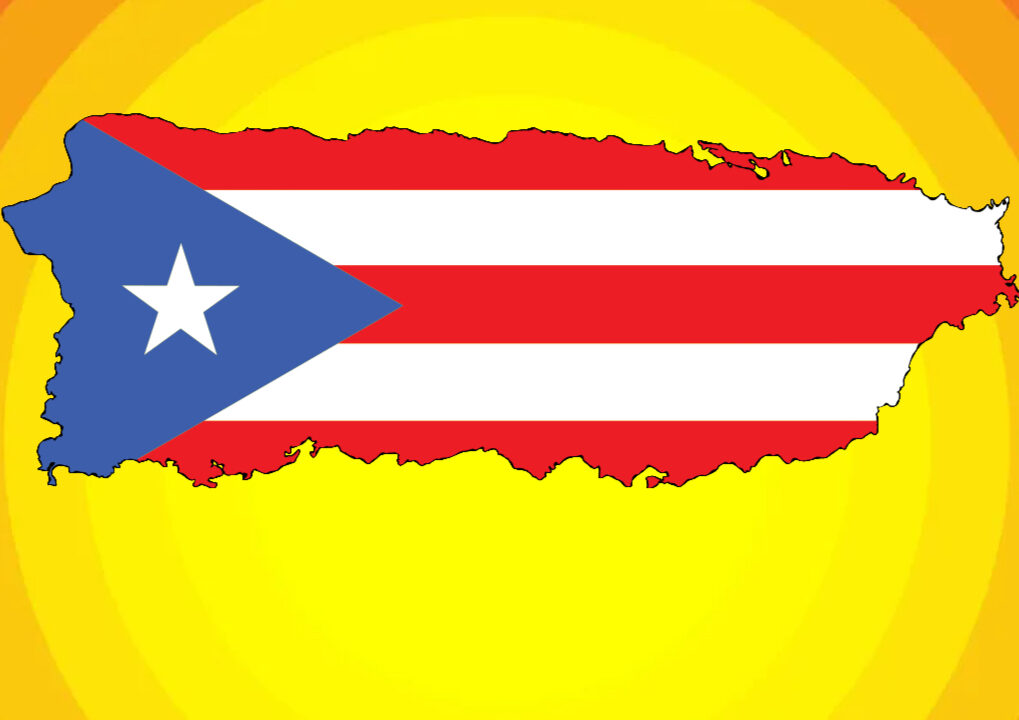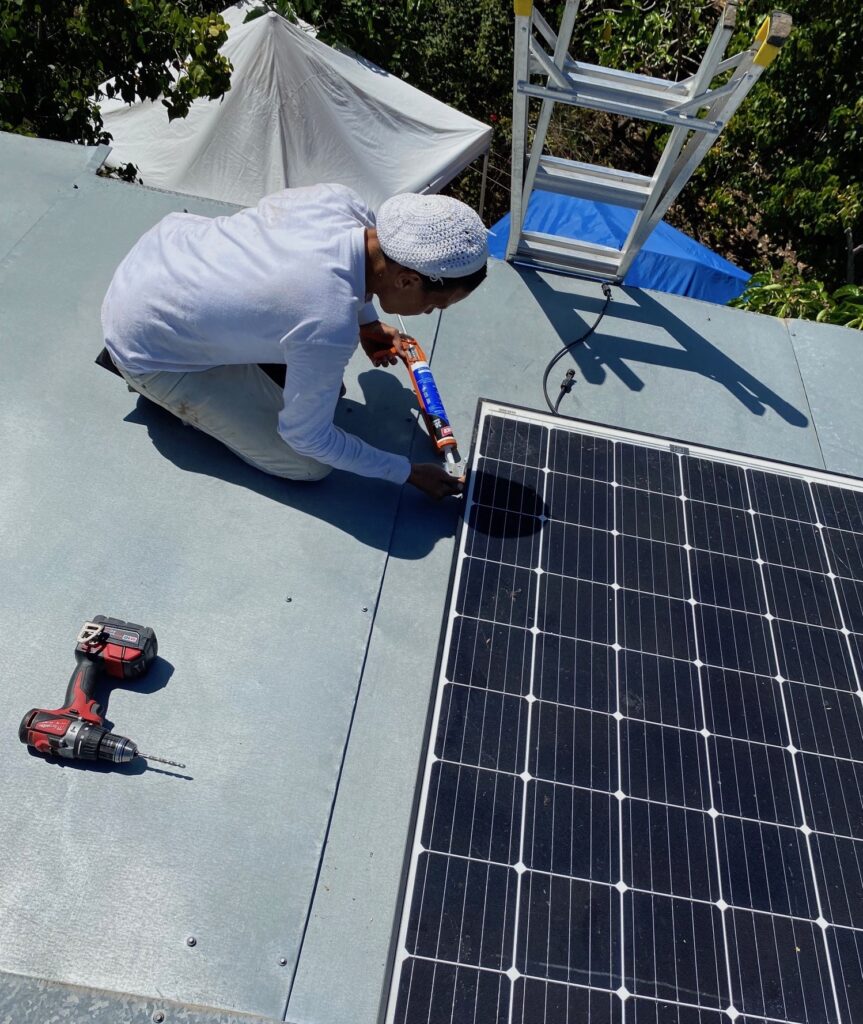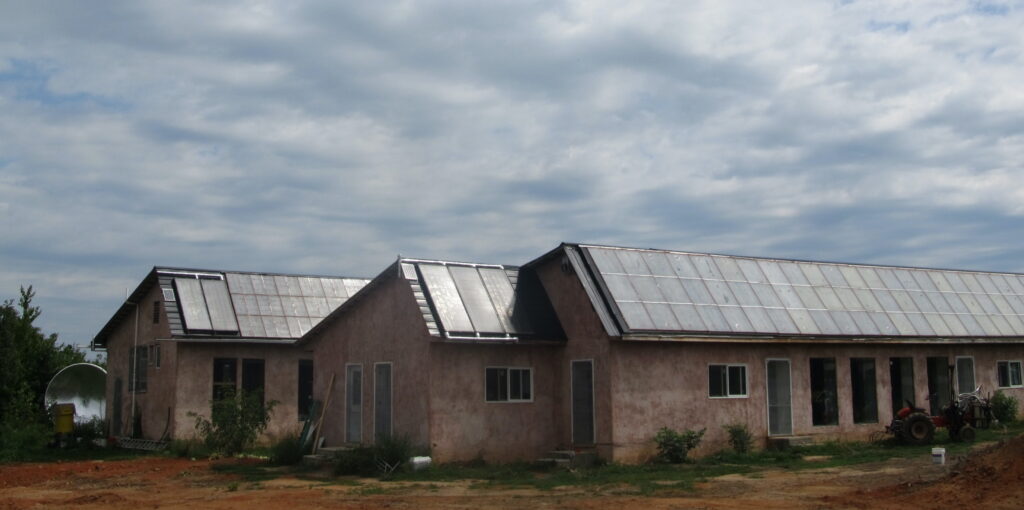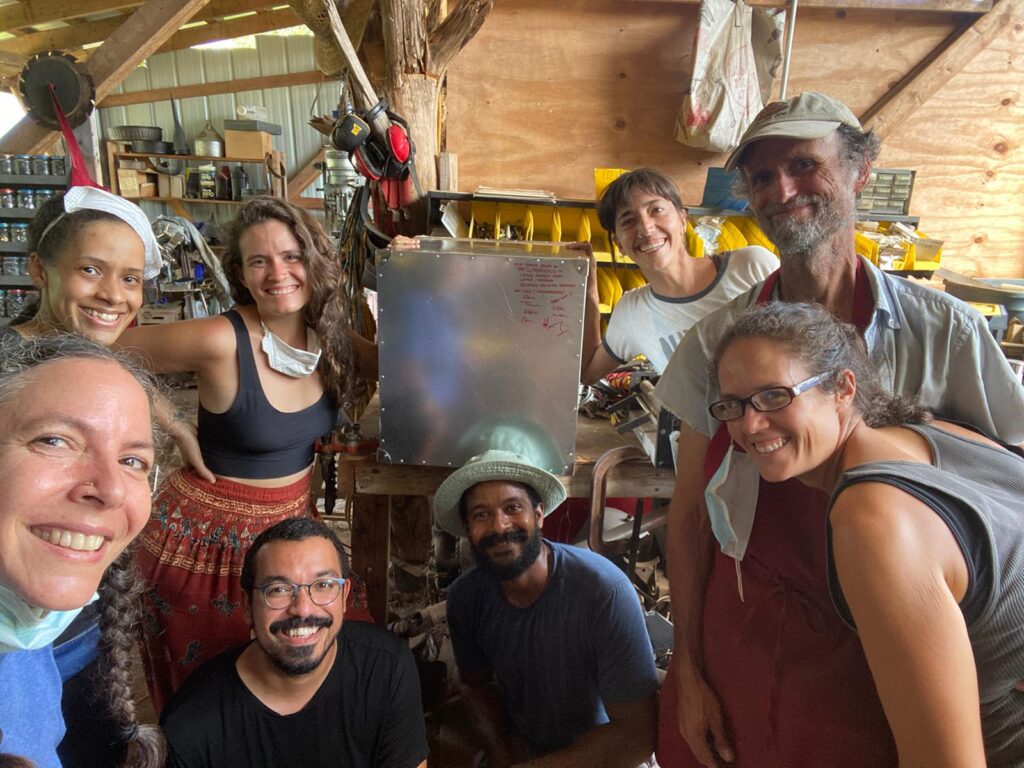Decolonizing Puerto Rico Through Solar Power
The island’s grid is old, expensive and unreliable. Can a solar system developed on a Virginia farm provide a sustainable alternative? Image by Truthdig
Image by Truthdig
After Hurricane Maria decimated Puerto Rico’s infrastructure in September 2017, Tara Rodríguez Besosa got busy rebuilding the local food system. There was no shortage of work to be done. The storm destroyed the island’s power grid, leaving millions without electricity and causing extensive damage to hundreds of thousands of buildings. In the mountainous region around the city of Caguas, Besosa and other founders of El Departamento de la Comida, a restaurant and nonprofit produce store, joined one of the “solidarity brigades” that had sprung up to repair local farms. While Besosa and her fellow activists fixed roofs, built rainwater collection systems and installed solar energy systems, they engaged in a discussion about the future of food in Puerto Rico: what needed rebuilding, and what needed replacing.
Out of this conversation, says Besosa, emerged an “understanding that there isn’t going to be food sovereignty if we aren’t also achieving energy sovereignty.”
In Puerto Rico, the energy conversation begins with the island’s antiquated electrical grid. Already decrepit for years before Maria, it has not improved much since. The island still suffers constant outages. Due to the U.S. colonial government’s policies, the grid relies almost entirely on imported fossil fuels, with coal ash disposal sites concentrated in low-income areas along the southeastern coast, where they release harmful toxins into the air, water and soil.

A main component of any solution, as you might imagine for an island in the Caribbean, will involve solar photovoltaic power. In particular, and especially for rural farms, this means micro solar systems designed for off-grid living. And while some Puerto Ricans have already begun turning to off-grid energy solutions like solar microgrids, most versions rely on costly battery storage to run when the sun isn’t shining. This makes them inaccessible for most residents of wealthy countries, let alone Puerto Rico’s poor rural citizens.
In March of 2022, Besosa was introduced to a couple from central Virginia who were working on a possible solution to this very problem. The husband and wife team of Alexis Zeigler and Debbie Piesen lived in an intentional community called Living Energy Farm in the rural township of Louisa, Virginia, where they had developed a solar energy system called Direct Drive DC Microgrid. They struck upon the design in 2010 using a non-electric storage system using thermal mass and insulation when the sun isn’t shining, minimizing the need to purchase expensive battery storage.
“Massive battery banks are not affordable and are therefore an irrelevant solution to our renewable-energy problem,” says Piesen.
Due to the U.S. colonial government’s policies, the grid relies almost entirely on imported fossil fuels, with coal ash disposal sites concentrated in low-income areas along the southeastern coast, where they release harmful toxins into the air, water and soil.
In January of 2023, Besosa helped Zeigler and Piesen organize an extended visit to Puerto Rico. During two months on the island, the couple installed their micro-solar system at three community centers and six residences as part of the final round of a competition, “Empower a Billion Lives,” organized by the Institute of Electronic and Electrical Engineers. In March, the invention received an Honorable Mention at the IEEE’s Global Energy Access Forum in Orlando, Florida, along with a prize of $5,000. As LEF begins to work with engineers who expressed interest in their model at the IEEE conference to apply this technology within the context of other models, Piesen says they want to expand their project in Puerto Rico.
This expansion is urgently needed by millions in Puerto Rico dealing with the psychological toll of frequent power outages. “I think that is really the single most important thing we could be doing,” says Epic Jefferson, who coordinated an installation at a community center near his childhood home in the San Juan barrio of Cupey.
The problem is especially acute for older residents who depend on air conditioning in Puerto Rico’s tropical climate.
“The priorities change when you get to a place like Puerto Rico,” says Jefferson. “The issue is, ‘How can we prevent death?’”
* * *
Zeigler and Piesen met in 2009 at Twin Oaks Community, an intentional community in Louisa, Virginia. Piesen worked on the farm, while Zeigler gravitated toward engineering, where he acquired a range of skills around utilities and carpentry. While living at Twin Oaks and similar communities during the 1990s, he began designing and building community-scale renewable energy systems, learning what worked and what didn’t. In 2008, he had the idea to start an intentional community that would run without the use of fossil fuels.

In 2010, the couple founded Living Energy Farm in Louisa as an off-grid organic farm and appropriate technology center. During their first year, they developed the DC Microgrid system that continues to power their farming community of six adults and two children, as well as a seed business. (Disclosure: The author is a former intern of Living Energy Farm).
The vision behind LEF, says Piesen, is “to demonstrate a way of life that everyone on the planet could afford, both environmentally and financially. They’ve been fed this packet of greenwashed B.S. from the mainstream environmentalist movement that says, ‘It will all be fine because we’re going to run the grid on renewables and you don’t have to worry about how much electricity you’re using.’”
LEF’s system uses daylight drive, or direct DC power, to run during the day, relying on non-electric storage at night. For example, when a DC solar refrigerator isn’t running, the food itself stores energy as thermal mass. If the fridge isn’t full, one can store large jugs of water on the bottom shelf to make sure the food stays cold. Because heavy loads run daylight drive, much smaller battery sets can be used, and high-quality, durable batteries become much more affordable. LEF uses nickel-iron batteries, which can last 50 years or more, to power lights, fans and electronics.
“We knew durable battery technology existed, we knew about direct drive, and had heard about running things DC, but nobody else had taken it to a community scale,” says Piesen.
Knowing they wanted to run a farm and irrigate, they made the well pump their first priority. Once they found they could run the pump on DC, Zeigler had the idea to try running a seed blower, thinking that both could not possibly run at the same time. “It worked, because DC motors can share power in ways AC motors can’t,” she says.
Zeigler and Piesen met in 2009 at Twin Oaks Community, an intentional community in Louisa, Virginia.
Most AC motors, Piesen explains, require quantities of constant voltage, which is not what comes off a solar panel, where the current and voltage constantly change. LEF uses permanent-magnet DC motors, which are easily available, inexpensive and can tolerate the large voltage swings that come from a solar panel in varying weather. As the voltage increases and decreases with changes in the weather, the motors go faster or slower, which means if you run multiple motors that are drawing more power than the solar panels are supplying, the work just gets done a bit slower.
In Puerto Rico, as in the Caribbean generally, the climate has proven to be an ally in using solar energy without battery storage because heating is not a concern as in temperate climates. In 2021, Zeigler traveled to Jamaica, where electricity prices are among the highest in the world, to install the systems with on-the-ground partners. The following year, they received a grant to work in Puerto Rico as a follow-up to that project and began making local contacts through the intentional communities’ movement. This led them to Besosa and El Departamento de la Comida.
“Connecting with Tara is where things started to take off,” says Piesen.
* * *
Before Maria made landfall, the energy infrastructure was already vulnerable from years of disinvestment and mismanagement. After the Puerto Rican government accrued $72 billion in debt to Wall Street, President Barack Obama established an oversight board in 2016 to control the island’s finances. Among its barrage of austerity measures were budget cuts to the state-owned Puerto Rico Electric Power Authority, which managed the grid until its privatization in 2021. Today, Puerto Ricans still experience persistent outages, yet pay more than double the U.S. average in energy costs.
In the wake of Hurricane Maria, a slew of AC solar companies began popping up in Puerto Rico. This made local energy sovereignty advocates like Millo Huertas Hernández suspicious. The message seemed to be, “Just plug it in, and you have the same consumerist mentality,” says Hernández, who appreciates that LEF’s DC systems are “a completely new way of understanding how much you consume, and why.”
Most AC motors, Piesen explains, require quantities of constant voltage, which is not what comes off a solar panel, where the current and voltage constantly change. LEF uses permanent-magnet DC motors, which are easily available, inexpensive and can tolerate the large voltage swings that come from a solar panel in varying weather.
When LEF reached out to Besosa with DC Microgrids, it perfectly fit the mission of El Departamento de la Comida (El Depa), which opened in 2010 as Puerto Rico’s first multifarm community-supported agriculture program, focused on purchasing produce from local farms and distributing them to clients on a weekly basis. El Depa expanded in 2012 into a restaurant and nonprofit produce store, only to see the space that housed it flooded by Hurricane Maria. After reopening in 2019 as a food sovereignty nonprofit, Depa supports farms and food projects around the region with a 2,000-square-foot processing kitchen, where farmers who have excess produce can make nonperishable items like jams. The space also has a tool library, a community seed library and an educational-materials library. They host open houses once a month, and workshops on topics like fermentation, use of tools and ancestral agroecological practices. The workshops use a skill-share model that emphasizes and facilitates exchanges of knowledge.
The Depa collective supported the idea of holding trainings at LEF in the summer of 2022. Together, the two communities coordinated two groups of 15 people from Puerto Rico — including electricians, activists, farmers, entrepreneurs and cooks — to travel to Virginia for a two-week immersion course in the daylight drive DC model. Both groups stayed at the farm, where they did chores and became familiar with the appliances.
“We used LEF as a living, breathing model of the technologies we wanted to learn from,” says Besosa. “It was a wake-up call for everybody that went to the training that there are ways to harness the energy of the sun that don’t require [a major] investment in battery storage.”
One year later, however, a lack of supply chains for DC equipment presents significant challenges to scaling up LEF’s model on the island.
“A lot of this equipment exists, but it’s not available on the retail market,” says Piesen.
* * *
After a brief trip in November to visit potential installation sites, Piesen and Zeigler traveled to Puerto Rico in January 2023. Their first stop was Fundación Bucarabón, an organization in Maricao that partners with Depa, where they installed a DC water pump, fridge and solar cooker. Focused on creating economic opportunities in the poverty-stricken agricultural town of Maricao, Fundación Bucarabón began in 2018 when six locals occupied Francisco Vincenty Second Unit School, one of hundreds of schools closed by Puerto Rico’s Department of Education since the debt crisis. Maricao is one of many communities to respond to a school closure by reclaiming the space. There may be more solar power in Maricao’s future, with an energy cooperative planning to develop a community microgrid there.
People at the LEF trainings the previous summer had emphasized that solar refrigerators would be key in Puerto Rico’s climate.
“That’s what people are really stressed about when they lose power — that their food is going to go bad,” says Epic, who attended a training. “Then there’s keeping medicines cold. Those are the people who are really affected with life-threatening issues with losing power in Puerto Rico.”
The DC refrigerator takes some getting used to, says Piesen, due to the need for thermal mass to stabilize the temperature. A full refrigerator will stay cold more consistently than an empty one, so the people receiving DC refrigerators are advised to keep their fridge full of food, or add jugs of water for thermal mass.
The system installed at El Departamento de la Comida includes a DC fridge and freezer, as well as battery kits for lights and charging stations. The power goes out often in their remote area, but Besosa says the DC system has already made a difference. “During our last open house, the electricity got cut off, and we had a fridge and freezer to rely on. We had a charging station to rely on, which was amazing,” she says.
One DC appliance they installed was the Insulated Solar Electric Cooker (ISEC), which involves a PV panel connected to a burner that turns electricity into heat. LEF has been working with the ISEC since 2020, when it was contacted by its inventor, a Cal Poly physics professor named Pete Schwartz. Zeigler started adapting Schwartz’s idea to more high-power designs, and the results are solving what had been one of the project’s biggest technical challenges: powering kitchens from morning to night. Cooking “takes a lot of energy and you want to do it multiple times a day, regardless of the weather,” says Piesen.

Another stop on LEF’s visit was a coconut farm in Arroyo owned by an elder couple named Miguel and Dinorah. Along with Millo, volunteers and the Depa team, they spent two weeks installing six solar panels to run a DC fridge/freezer and cooker — what Piesen calls an “ambitious, complicated system.” They also put in a DC water pump so the farmers could have running water and a functioning toilet, replacing the manual pump Miguel had used to pump gallons of water in order to flush the toilet, bathe and irrigate.
After the system was installed, Miguel and Dinorah hosted a skill-share at the farm. Around 30 people came to learn about daylight drive and the new appliances. Besosa says the presentation was followed by a lively discussion about “our responsibility beyond having renewable technology, and the practices we have around using energy and when.”
Puerto Rico’s colonial status and history makes conversations like these important, notes Besosa: “When you have people coming in from the outside, like LEF, it’s very important to really listen to what the community knows, where the community is at and what our community needs.”
* * *
Piesen and Zeigler see huge potential for other parts of the world with little or no grid, but financing is a major obstacle, and they are currently looking into government support programs. “We want to work wherever there’s a demand for it,” says Piesen. “The question is, how can we bring down the cost and increase the volumes so it becomes affordable and scalable?”
The next step in the Depa team’s expansion plans is traveling to spread knowledge of the Direct Drive DC Microgrid model to other islands in the Caribbean. Right now, Besosa points out, Puerto Ricans have very little contact with the countries that are closest to them geographically. The Depa team’s vision is to bring Caribbean countries together in a shared struggle for food and energy sovereignty.
“Ever since we became a colony, there has been a movement for independence,” says Besosa.
“But we are not waiting for a change in our political status to start creating more autonomous communities in Puerto Rico.”
To learn how you can support this project, visit Living Energy Institute or Departamento de la Comida.
Your support is crucial…With an uncertain future and a new administration casting doubt on press freedoms, the danger is clear: The truth is at risk.
Now is the time to give. Your tax-deductible support allows us to dig deeper, delivering fearless investigative reporting and analysis that exposes what’s really happening — without compromise.
Stand with our courageous journalists. Donate today to protect a free press, uphold democracy and unearth untold stories.





You need to be a supporter to comment.
There are currently no responses to this article.
Be the first to respond.